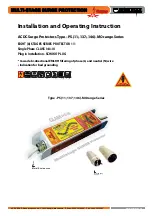
Operation
TPS3 surge protective devices require minimal attention after
installation. TPS3’s contain diagnostic circuits which monitor the
suppressor's status continuously and automatically. All phase indicators
and controls are located on the display panel of the unit. Display
panels are formatted either for horizontal or for vertical mounting
orientation as required for each application.
TPS3 Control and Diagnostic Display Panel
TPS3’s are equipped with a status indicating LED for each phase on
the panel. When all LED's are green, the suppressor is on-line and
functioning properly. If a fault condition occurs, the audible alarm will
sound, the Red Service LED will illuminate and the LED representing the
affected phase will extinguish, indicating that the unit needs service.
The audible alarm can be silenced by pressing ALARM SILENCE on
the touchpad. The audible alarm and Dry Contact can be tested by
depressing TEST. If a fault alarm occurs, see Corrective Maintenance
(Testing and Repair) for further information.
Display Panel with Surge Counter Option
The surge counter option provides a means to display the total number
of transient voltage surge events since the counter was last reset. The
counter includes Eprom memory, which retains counter memory in
the event of a power loss. The RESET touchpad will reset the counter
to zero. The COUNT touchpad increments the counter by one (1)
and tests the circuitry for proper operation. If a fault alarm does
occur, see Corrective Maintenance (Testing and Repair) for further
information.
Figure 8: DISPLAY - HORIZONTAL
(SHOWN WITH SURGE COUNTER)
Phase A, B & C:
Green LED indicators—one per phase. Green is good.
Extinguished green LED indicates loss of protection. Every suppression
element in this SPD is monitored. N-G suppression element monitoring
is logic-connected to Phase A.
Service LED (red):
LED illuminates in the event of problems. This
indicator is logic-connected to the Phase LEDs. Should a Phase LED
go out, the Service LED will illuminate and the Audible Alarm will
sound.
Test:
Tests red Service LED and Audible Alarm, and changes state
of Dry Contacts
Alarm Silence:
Turns Audible Alarm off. (Alarm is deactivated when
the Silence LED is illuminated.)
Surge Counter Count:
(if equipped) Increments optional surge
counter by one (+1)
Surge Counter Reset:
(if equipped) Resets optional surge counter
to zero (0)
Figure 10: DRY CONTACT CONNECTION CONFIGURATION
NO
DRY CONTACTS
NC NC C NO
C
Dry Contacts Feature
TPS3 01, 05, and 06 units are equipped with dry contacts. This feature
provides Normally Open (N.O.) and Normally Closed (N.C.) circuits,
which can be used for remote indication of a failed transient voltage
surge suppressor. There is only one dry contact output consisting of
two electrically isolated sets of NC-C-NO contacts. This dry contact
output changes from "normal" to "alarm" if any problem occurs inside
the SPD (i.e.: loss of power to any phase, any thermal protector inside
the SPD opens, or any fuse inside the SPD opens). The dry contact
terminal block is located on the back of the module, opposite side of
bus tabs. This connector is designed for low voltage or control signals
only. Maximum voltage should not exceed 240 volts and maximum
current should not exceed 5 amperes. These contacts may be used to
provide a signal to an emergency management system or computer
interface board. The relay contact pin arrangement is outlined in the
table below.
The Normally Closed (N.C.) configuration is recommended because
it will detect a wiring defect, such as a cut wire(s), where Normally
Open (N.O.) will not.
Figure 9: DISPLAY - VERTICAL
(SHOWN WITH SURGE COUNTER)
10


































